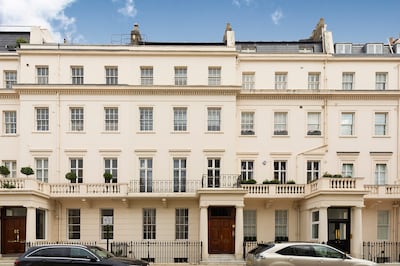London’s super-prime property market has had its strongest year since 2016, with the upturn attributed to the lifting of pandemic restrictions and the uncertainty fading following the Brexit vote.
The highest number of £10 million-plus ($12.6 million) deals in the capital took place in Kensington (26), followed by Belgravia (25) and Mayfair (22).
A total of £3.1 billion was spent on 161 super-prime properties in the year to March 2023, market data from Knight Frank shows.
Over the past year, £2.5 billion was spent in 144 transactions.
The last time there were more sales was in the year 2015-16, when there were 164.
Demand was boosted as international travel resumed from many parts of the world last year.
The political uncertainty that followed the EU referendum in 2016 had begun to dissipate following the election of a majority government in December 2019, but Covid-19 struck four months later.
Both supply and demand were relatively strong in the first quarter of this year compared to the five-year average, underlining the likely resilience of the market this year.
The number of new prospective buyers registering above £10 million rose by 15 per cent while the number of properties coming to the market for sale increased by 11 per cent.
“After everything that has happened in recent years, London is still highly regarded by global buyers,” said Paddy Dring, global head of prime sales at Knight Frank.
“However, I expect sales volumes will decline by at least 10 per cent over the next 12 months as political and economic uncertainty picks up.”

The decline would be in line with the wider UK property market, which is still recovering from the shock of the mini-budget.
Sales volumes across the UK were 18 per cent down in the first two months of this year compared to 2022 but are rising steadily as mortgage rates stabilise.
The strong year for the super-prime market came despite the collective wealth of ultra-high-net-worth individuals around the world declining by 10 per cent in 2022.
Those who have at least $30 million saw their worth decline as economies dealt with an energy price crunch, as well as fast-rising inflation and interest rates.
This year, the bailout of Credit Suisse in March and wider concerns around the health of smaller banks have caused some hesitation.
Meanwhile, the next UK general election, which is expected in 2024, is moving on to the radar.
Issues such as the taxation of wealth and property and the status of non-domiciled individuals are likely to come under growing scrutiny.
“Discussions around the general election have started to creep into conversations,” said Christian Lock-Necrews, head of the Knightsbridge office at Knight Frank.
Popularity of houses in decline
Meanwhile, the popularity of houses declined slightly from last year.
About 67 per cent of sales were houses compared to 70 per cent in the year to March 2022, a period when lockdown restrictions increased demand for space.
In the 12 months before the pandemic, 60 per cent of transactions were houses.
“Houses still have the edge over flats which means there is a shortage of stock in areas like Notting Hill and Belgravia,” Mr Dring said.
A declining number of luxury new-build flats coming to the market may keep the ratio of house sales relatively high.
The number of units consented, under construction or delivered every year in developments where the value is £3,000 per square foot and above will fall sharply over the next five years.
“There will be a material reduction in the amount of new-build stock over £10 million compared to 2014,” said Rupert des Forges, head of prime central London developments at Knight Frank.
“Significant prime schemes are still coming through, but buyers need to be aware of this relative shortage.”
Average prices above £10 million rose by 0.5 per cent in the year to March, which is the same increase recorded in the three years since the pandemic first struck in March 2020.
Knight Frank expects prime central London prices to decline by 3 per cent this year.
However, London will outperform the wider UK housing market due to higher levels of affluence and cash sales, the return of international travel, the currency discount and prices still sitting 14 per cent below their last peak in 2015.
US dollar-denominated or pegged buyers still benefit from an effective discount of 37 per cent in prime central London compared to July 2014, when taking into account the movement of the pound and property values.
Prime property market outside London sees record year
Outside the capital, there was a 16 per cent increase in sales on a year earlier - the highest total in 15 years
Tight supply and resilient demand mean buyers looking to secure a prime property outside London are still facing strong competition even as the "race for space" calms down, Knight Frank said.
There were 52 sales above £8 million outside of London in the 12 months to March 2023, market data shows.
This was an increase of 16 per cent on 45 a year earlier and the highest total in 15 years.
Sales of properties priced above £5 million reached 122 in the same period, which was the second highest total in the past 15 years.
There were 157 sales in the 12 months to March 2022.
As well as the "escape to the country trend", strong demand for high-value property outside of London is the result of wealth creation that has taken place in recent years, as well as the relative value compared to London over the past decade.
“There are plenty of buyers in the market and the best properties are still selling quickly,” Tom Hunt of Knight Frank’s Country Department said.
“Anything that needs updating or work done is taking slightly longer to sell as there’s less appetite among buyers to take on a project due to the increase in building costs,” he added.
Supply was 7 per cent down in the 12 months to March compared to the previous year, which shows how it is picking up from a low base.
The number of new prospective buyers looking for properties priced over £5 million outside the capital has declined from a peak in the third quarter of 2020.
However, it remained 13 per cent above the five-year average in the first quarter of 2023.
“We’ve seen a shift in priorities,” said Ed Rook, head of the Country Department at Knight Frank.
“People deciding to move that rung further outside of urban centres knowing that they don’t have to be right on top of a station as they are now only in the office three days a week."







